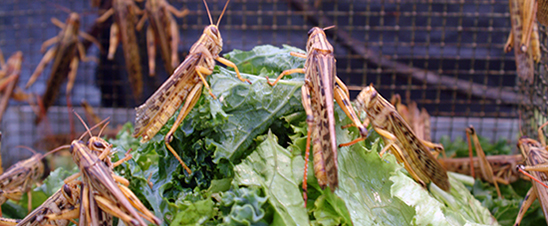Hymenoptera
Hymenoptera is one of the largest orders of insects, and includes common insects such as sawflies, wasps, bees and ants. This group of insects is named Hymenoptera because of their heavy wings. They range in size from very small to large and usually have two pairs of wings.
Most insects in this group are herbivores because they eat mostly leaves or pine needles. Some of the insects in this group are predators, like the stinging wasps, which paralyze their prey and use this as food to feed their larvae. This group of insect also includes bees who will feed on nectar and pollen.
The Hymenoptera order of insects will undergo complete metamorphosis, which means that they have a worm-like larval stage which will change into a pupa and from there they will hatch and mature into adults.

Orthoptera
Grasshoppers belong to the order of insects called Orthoptera. They are related to crickets and katydids but look different because they have larger hind legs and short, thick antennae.
Grasshoppers are primarily herbivores and feed on various plants but will occasionally eat other insects.
They have a life cycle that begins from eggs that will then transform into nymphal stages or instars and finally mature into adults.

Read more about: Ugly Bug Contest 2012
Bibliographic details:
- Article: Hymenoptera and Orthoptera
- Author(s): Dr. Biology
- Publisher: Arizona State University School of Life Sciences Ask A Biologist
- Site name: ASU - Ask A Biologist
- Date published:
- Date accessed:
- Link: https://askabiologist.asu.edu/activites/ubc/hymenoptera
APA Style
Dr. Biology. (). Hymenoptera and Orthoptera. ASU - Ask A Biologist. Retrieved from https://askabiologist.asu.edu/activites/ubc/hymenoptera
Chicago Manual of Style
Dr. Biology. "Hymenoptera and Orthoptera". ASU - Ask A Biologist. . https://askabiologist.asu.edu/activites/ubc/hymenoptera
Dr. Biology. "Hymenoptera and Orthoptera". ASU - Ask A Biologist. . ASU - Ask A Biologist, Web. https://askabiologist.asu.edu/activites/ubc/hymenoptera
MLA 2017 Style
Be Part of
Ask A Biologist
By volunteering, or simply sending us feedback on the site. Scientists, teachers, writers, illustrators, and translators are all important to the program. If you are interested in helping with the website we have a Volunteers page to get the process started.


